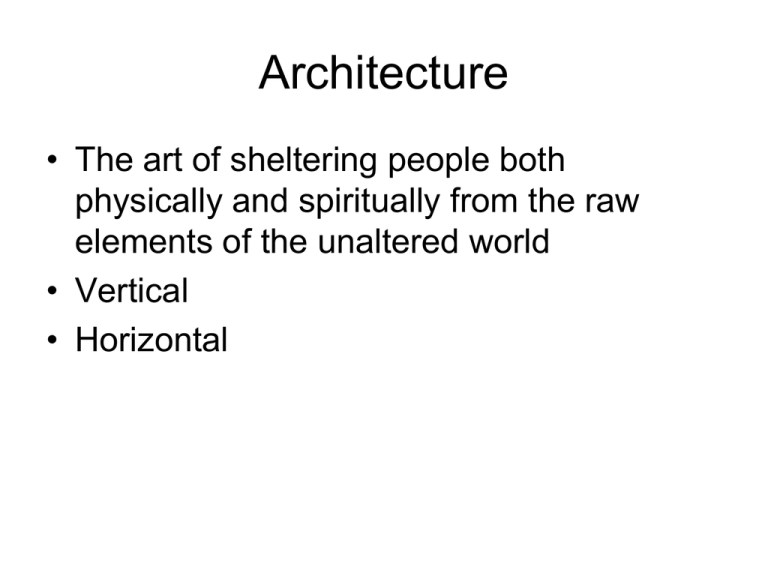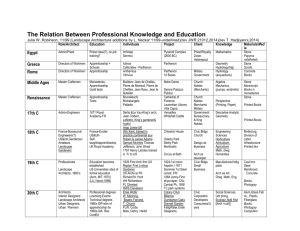Architecture: Structural Systems & Design Principles
advertisement

Architecture • The art of sheltering people both physically and spiritually from the raw elements of the unaltered world • Vertical • Horizontal Great Pyramids at Giza -2600 BCE Post & Lintel • Horizontal beams laid across open space between vertical supports • Limited by lack of tensile strength withstands bending • Has compressive strength- withstands crushing Columns • Columns- consist of a shaft, base, capital • Fluting- may be carved vertical lines on the shaft • Base- may be none, stepped, or elaborately stepped • Capital- uppermost section, transition from top of column to lintel Greek Architectural Orders • Doric Order- simple shaft, no base, curved shape supporting a squared capital • Ionic- shaft with fluting, rests on stepped base, carved scrolls on capital called volutes • Corinthian- most complex, fluted column rests on a detailed, stepped base with carved, stylized acanthus leaves on the capital Doric Ionic Corinthian Arch Construction • Stresses transfer outward from center (keystone) to legs: does not depend on tensile strength of materials • Round- Roman • Horseshoe- Moorish • Lance- pointed, Gothic • Ogee arch Arch types Arch Construction • Perfected by the Romans by 2nd c. BCE • Can define large spaces because the stress is transferred from the keystone to the legs • Keystone- wedge-shaped central stone in the arch; it is inserted last & locks the other stones in place • Vault- arched masonry structure that spans an interior space Joined Arches • • • • • Arcade- a series arches placed side by side Tunnel vault- half-round arch extended in depth, arches placed back to back to enclose space Groin vault- formed by the intersection of two barrel vaults of equal size at right angles Ribbed vault- tunnel or groin vault in which the lines marking the diagonal intersection of the vaults are reinforced with raised masonry Dome-arch rotated 360 degrees on its vertical axis Arch Supports • Buttress- reinforcement to the legs of an arch to prevent them from caving outward • Flying Buttress- buttress designed to overcome bulk of stone by accomplishing structural ends that were light in appearance Contemporary Structural Systems • Cantilever- overhanging beam or floor supported only at one end • Bearing wall- the wall supports itself, the walls and the roof • Skeleton frame-a framework supports the building, the walls attach to the frame forming an exterior skin Variations • Skeleton frame – 1. Balloon construction: When the framing utilizes wood, as in house construction – 2. Steel cage construction: When the metal forms the frame, as in skyscrapers Building Materials • Stone- post & lintel; also combined with mortar or brick & mortar, called masonry • Concrete- pre-cast concrete (cast in place using wooden forms around steel) • Ferro-concrete (reinforced concrete) • Wood- balloon framing or post & beam • Steel: steel cage, cantilever • Steel suspension (bridges, superdomes, aerial walkways) • Geodesic dome Stone Masonry Concrete Pre-cast Concrete Wood Steel Steel Suspension Common Terms • • • • • • • Line, forms, repetition Materials, texture Balance Scale & proportion Color Light Space: how do the forms (walls, ceiling, stairs, entries, roof) enclose the space Architectural Considerations • Structural system • Context- the environment. How does the example relate to the physical environment – in contrast to or reflective of surroundings • Circulation: design and flow of contiguous spaces relative to function • Climate• Function- the purpose of the building • Dynamics- stability, instability & movement • Style- historical reference











